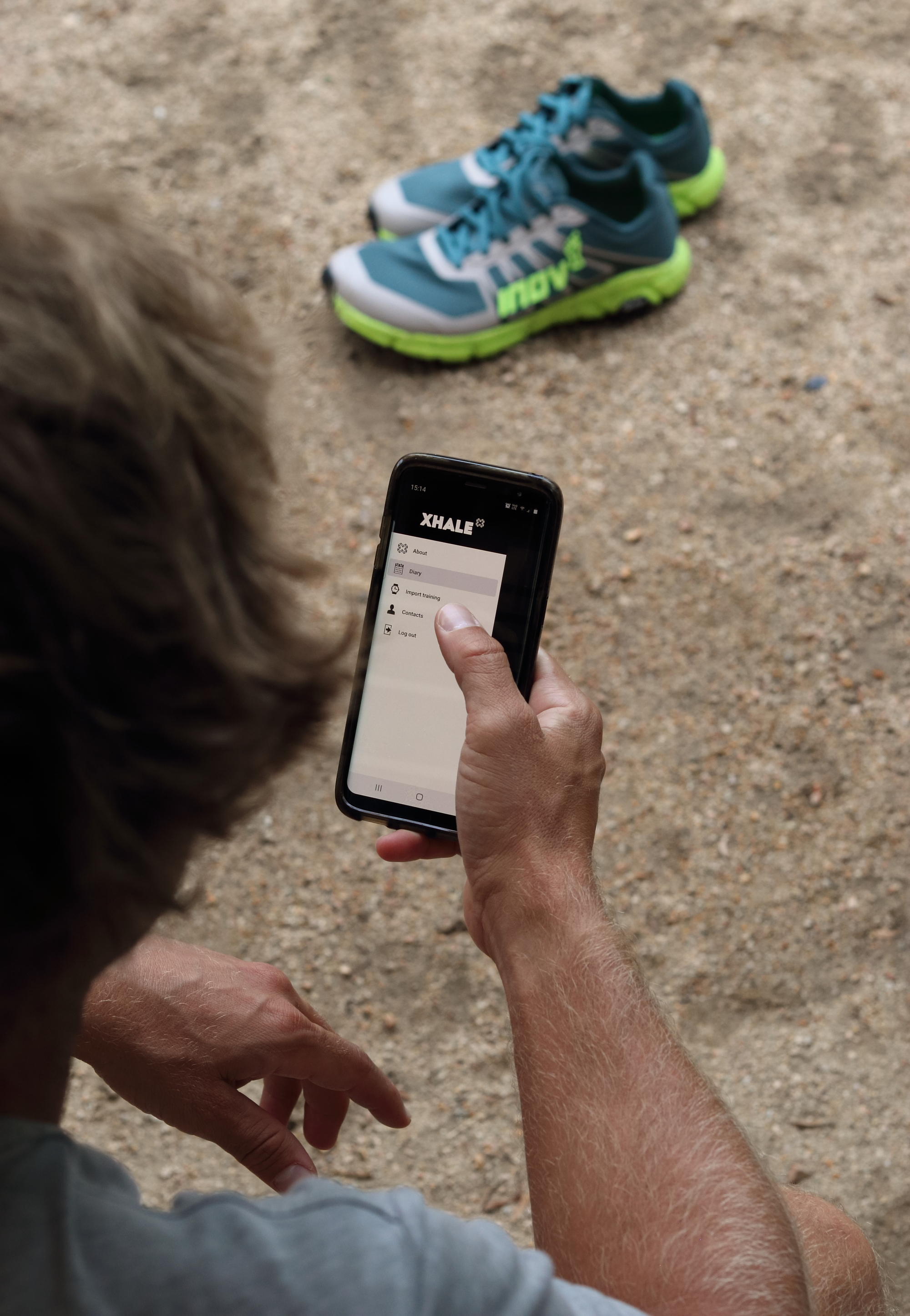Pierre Jordaan and Nicolette Griffioen, Mountain Abandon

The use of RPE dates back to the 1960s when the Borg rating of perceived exertion scale was created by Dr Gunnar Borg, a Swedish psychologist, physiologist and philosopher. Originally designed as a scale of exertion from 6 to 20 and used for patients in a medical context, today one can find many variations of Borg’s system. This is especially true in the world of sports, coaching and endurance exercise, which is the focus of attention in this article.
Rating of Perceived Exertion (RPE) is typically seen as a subjective measure of feedback – based on or influenced by personal feelings and opinions. The word “perceived,” however, actually has two listed definitions.
- become aware or conscious of (something); come to realise or understand.
- interpret or regard (someone or something) in a particular way.
The second definition here supports the notion that RPE is a subjective measure of an athlete’s physical exertion – it’s their interpretation of how hard they feel they’re working, or worked, during a particular training session or competition. The first definition, however, lends itself to a slightly more objective take. An athlete becoming aware of how hard they’re working gives a greater impression of them assessing something tangible, finite and real. This is our thinking on RPE – it’s a combination of subjective and objective feedback and it fills an important gap between the two. Our purpose for analysing this is to convey to athletes (and probably some coaches too) that RPE is not just an emotional classification system. Yes, emotions do tend to influence the RPE score of a session, but then emotions influence how we train, race and perform anyway, so surely they’re important in feedback?
In our coaching we prioritise RPE over most other tools for assessing intensity, effort and fatigue. But in fact, we value purely subjective feedback the most, so the first thing we “analyse” from an athlete’s training session are their written comments post-run.
But in fact, we value purely subjective feedback the most, so the first thing we “analyse” from an athlete’s training session are their written comments post-run.
Now, as with any training tool, it’s a good idea to educate athletes on the type of feedback that is most relevant here. We encourage a brief overview of how they felt physically, mentally and emotionally, as this usually enables us to better understand the rest of the data such as RPE, heart rate and pacing. The comments block is where the coach should read about niggles before they become injuries, excessive work stress before sessions start being missed, and nutrition concerns before the development of eating disorders. These are just a few examples of catching potential issues before they deteriorate further, but athlete comments are also great to identify when someone may have the capacity to increase their training load, or are peaking timeously for their goal race. Basically, whether negative or positive, good and proper communication is the cornerstone of any successful relationship.

Basically, whether negative or positive, good and proper communication is the cornerstone of any successful relationship.
On this note, in-person meetings or regular phone/ video calls are invaluable to the coach-athlete relationship. In a world of online EVERYTHING, it’s very easy to just go with the virtual flow. But the reality is that real conversations with tones of voice and facial expressions are still key elements to understanding other humans. And as coaches who offer “individualised coaching,” it is vital that we understand our athletes in order to prescribe the best possible training for their personal performance goals, whatever their nature.
Once we’ve read an athlete’s subjective response to a training session, the next thing we look at is their RPE feedback from Xhale’s RPE dropdown menu. Ideally the athlete’s post-session RPE selection will be in line with the intensity or nature of the workout scheduled by the coach, but this isn’t always the case. Occasionally an athlete may rate a session as significantly more effort or less effort than what the coach intended, but this shouldn’t happen regularly. For example, if Sally is scheduled to do a 30 minute active recovery run and rates it an RPE 6 (hard), then the coach should be checking Sally’s comments on the session (why did she find it hard; was she feeling ill?) and her objective data (was her pace too high or did she do a lot of ascent in the 30 minutes?) If the subjective and objective information available doesn’t align with the RPE rating then the coach should engage with Sally to dig deeper.

As with subjective feedback and post-session comments, there is a degree of education to ensure that RPE can be used as a valuable training tool. Using RPE to monitor and target workload accurately requires a good understanding by the athlete of what they’re trying to accomplish at each prescribed intensity level, the impact that intensity has on their body, and how best to detect and interpret those impacts. Respiratory rate is one of the best indicators of work being done as it is closely linked to the amount of carbon dioxide in the blood. As the muscles break down fuel for energy during a run, blood carbon dioxide levels increase. To keep this at a sustainable level, the heart rate is forced to increase and pump more venous blood through the lungs, and the respiratory rate similarly increases for more rapid exchange of CO2 for oxygen.
In this manner, increasing exercise intensity causes faster and deeper breathing. Because breathing rate affects the ability to talk, we encourage our athletes to use the Talk Test as an initial method of gauging intensity. At a recovery pace an athlete shouldn’t be breathing much faster than while walking briskly – they should be able to tell the full story of their last mountain without pause. At an endurance run or “forever” pace intermittent conversation should be relatively comfortable with regular pauses for breath. At higher-end aerobic efforts only two or three sentences at a time should be viable. This is followed by the lactate threshold range where a maximum of one sentence, five to seven words, is all an athlete should be able to mutter. And finally we have VO2 max intensity where just a single word might be able to escape between short and rapid gasps for air…
Mountain Abandon RPE Scale for Athletes

Even with an athlete knowing and following the above recommendations, the coach still needs to remember that every athlete is different and will interpret the RPE scale in their own way. But if an athlete realises the value in honest and consistent RPE scores, they will be more likely to provide accurate information on an ongoing basis. It will never be an exact science, but over time, a well-tracked RPE can start to show trends within an athlete’s training cycle. This can provide clues to the coach on when to reduce, maintain or increase training load in order to minimise fatigue and risk of injury, and maximise adaptation and performance. So show your athletes their acute and chronic fatigue RPE graphs, where the optimal zone lies, and thank them for frequent and relevant feedback.
…in using RPE you are deveoping and building the most powerful tool that any athletes can ever have – their brain.
There are several other benefits to using RPE over traditional tools when it comes to measuring training intensity. The first is that no special or expensive equipment is required. In fact, in using RPE you are developing and building the most powerful tool that any athlete can ever have – their brain. RPE forces the athlete to listen to and understand their body, a skill that’s on a rapid decline in our digital modern society. The brain is required to process and analyse all the information it receives during an athlete’s training session – feedback from the skeletal, muscular, neural, mental, emotional and environmental systems – and then provide an all-encompassing assessment of the effort that its attached body had to exert. To quote a well-known ultra running coach – “Your brain is the most valuable tool you have for monitoring and evaluating your intensity, and it’s the only training tool yet designed that can determine the correct interval and racing intensities for an ultra runner. Your job as an athlete is not to find the gadget that will give you the information you seek but, rather, to master the ability to gauge intensity and workload by perceived exertion. It’s the only information you need, which is good, because it’s also the only accurate information you have.”
To conclude, we always like to tell our athletes that No data is better than bad data… This is particularly true in trail and ultra running where adverse weather conditions, technical trails and dying device batteries frequently affect the quality of recorded data. Consider the 2023 Montane Spine Race for example. Snow, gale force winds, minus temperatures, sleep deprivation, nausea, excessive caffeine consumption – the post-race heart rate graph is not likely to provide much in the way of vital feedback, if the athlete even bothered to record in the first place.
But let’s admit – the Spine Race is really a bit of an anomaly. The sort that’s becoming more frequent and sought after, but still not the running that most trail runners enjoy. Our statement then – no data is better than bad data – does still beg the question: is there a place for good data (of the purely objective variety) in trail and ultra running? Look out for Part 2 of this blog where we discuss the pros and cons of heart rate training!

Based in South Africa, Pierre and Nicolette are the founders of Mountain Abandon. Both highly experienced ultra runners themselves, they provide not only coaching for their athletes, but offer guided mountain adventures in the Drakensberg mountains. Always seeking to learn from nature and the experiences of themselves and their athletes they embrace all types of coaching tools and science and enjoy sharing their expertise.
Got something to add?
If you would like to input to our Coaches’ Hub – or there is a topic you would like us to write about – why not send us your ideas? We are always looking for good content.
Email: caroline@trainxhale.com

1 comment
Comments are closed.